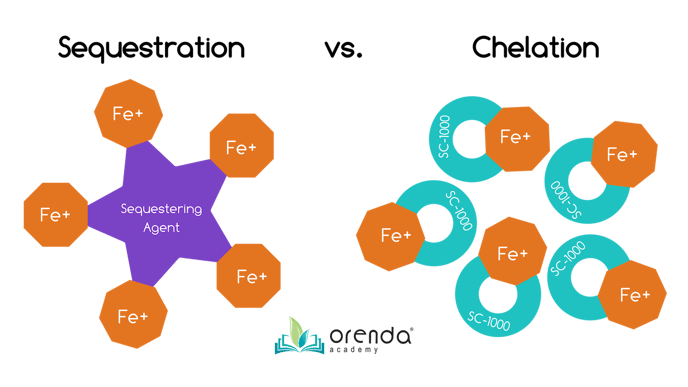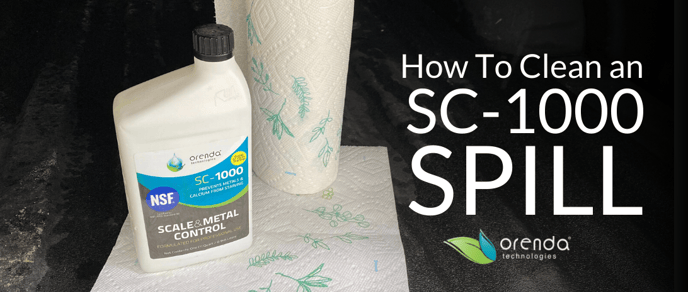SC-1000 Frequently Asked Questions
Here are the most commonly-asked questions we get about SC-1000.
SC-1000 Scale and Metal Control is our chelating agent. It binds to metals and minerals, holding them in solution. It prevents metals from being oxidized and staining, and it inhibits minerals like calcium from being carbonated and forming scale. We get a lot of the same questions about SC-1000. If this article does not answer your question, just ask us here.
Jump to:
- Will SC-1000 remove scale from pool surfaces?
- How do I remove metal stains with SC-1000?
- Does SC-1000 remove metals from water?
- What is the initial dose of SC-1000?
- What is the maintenance dose of SC-1000?
- Why does SC-1000 reduce chlorine levels?
- How do I clean up an SC-1000 spill?
- Can SC-1000 be used in saltwater pools?
Will SC-1000 remove scale from pool surfaces?
Yes, SC-1000 can break down and dissolve carbonate scale from pool surfaces IF given enough time to soak the scale itself. Tile line scale is a perfect example. If the scale is above the water line, then no, SC-1000 cannot reach it, and therefore cannot affect it. In that case, raise the water level above the scale line for a few weeks and use SC-1000 as directed here.
How do I remove metal stains with SC-1000?
Well, first of all, SC-1000 is not designed to remove existing metal stains. It is excellent at preventing stains, but not the best at removing them. Stains are the result of already-oxidized metals exceeding a saturation point in the water. Metals bound to SC-1000 will not be oxidized. The challenge is lifting the stain off the surface, then grabbing the metals. SC-1000 can do the latter, but you will need a citric acid/ascorbic acid product to lift the stains in most cases, and Orenda does not make one.
That being said, if you have SC-1000 already in circulation, you can then use a citric/ascorbic acid to lift the stain, and SC-1000 should be able to grab (chelate) the metals. The chelation rate depends on water temperature; the warmer the water, the faster the reaction. Under 65ºF, SC-1000 will be dormant.
Does SC-1000 remove metals from water?
No, SC-1000 will not remove metals; it will only chelate them and hold them in solution. In fact, if you are trying to remove metals, SC-1000 is not the ideal product for you. Consider a metal removal system and a sequestering agent. The sequestering agent will cluster metals together into a larger molecule, whereas SC-1000 individually isolates single metal ions. See our illustration below:

You need some sort of metal capturing device to trap and filter metals out of the water. SC-1000 is compatible with every system that we know of. But again, it is not made to remove metals from the water.
What is the initial dose of SC-1000?
The initial purge dose of SC-1000 is 1 quart per 10,000 gallons (32 fl.oz (0.94 L) per 10,000 gallons (38,000 L)). If your source water comes from a well, we recommend 1.5x that purge dose (48 fl.oz. per 10,000 gallons). This dose will wipe out chlorine levels, so it is sometimes best to divide up the purge dose over several days to prevent zeroing out free chlorine.
This initial dose is also The Orenda Startup™ dose of SC-1000.
What is the maintenance dose of SC-1000?
Regardless of pool size, the weekly maintenance dose of SC-1000 is 3 ounces per 10,000 gallons (3 fl.oz. (90 mL) per 10,000 gallons (38,000 L)). The initial purge is required, because SC-1000 needs a residual in the water to be effective. Simply starting the weekly maintenance dose without a purge will not be effective–at least until the weekly maintenance doses finally catch up to the initial purge amount.
Why does SC-1000 reduce chlorine levels?
As it was explained to us, SC-1000 cannot be oxidized by chlorine, but chlorine attacks it anyway. We know that isn't the most scientific explanation, but it's too complicated to articulate exactly what is happening without simplifying it. Basically what happens is chlorine tries to oxidize SC-1000, and fails. This reduces free chlorine levels. And chlorine will continue to attack SC-1000 until it has bound to a metal or mineral. Once chelation has occurred, chlorine ignores the molecule.
In other words, SC-1000 needs time to do its job, and until it does that job, you won't be able to hold a decent free chlorine level in your pool. The time it takes to chelate metals and minerals depends on water temperature; the colder the water, the slower SC-1000 works. The warmer the water, the faster. We have seen free chlorine levels be wiped out for up to four days before.
To get around this, we recommend dividing the purge dose up over 3 or 4 visits, with at least a day in between. You can even add it once a week for 3 or 4 weeks until the purge dose is in. Of course, the best time to add SC-1000 is before chlorine is added in the first place, which would be during startup.
How do I clean up an SC-1000 spill?
SC-1000 can be a mess to clean up if it spills, especially if you are trying to clean it up by wiping it off with a rag or paper towel. We have found a better way. Lay two layers of paper towels on the spilled SC-1000 to soak it up until it is completely dry. After the towels dry, it will have picked up most of the SC-1000, and cleaning up the rest is much easier. Read the entire cleanup procedure here.
Can SC-1000 be used in saltwater pools?
Absolutely! In fact, it's widely used by pool professionals that maintain saltwater pools, because it helps inhibit scale formation in the salt cell, which also helps prevent calcium flakes. SC-1000 has become the product of choice for keeping salt systems clean and minimizing calcium problems in salt pools. Even several of the salt system manufacturers are starting to recommend SC-1000 as part of a preventative maintenance program.
